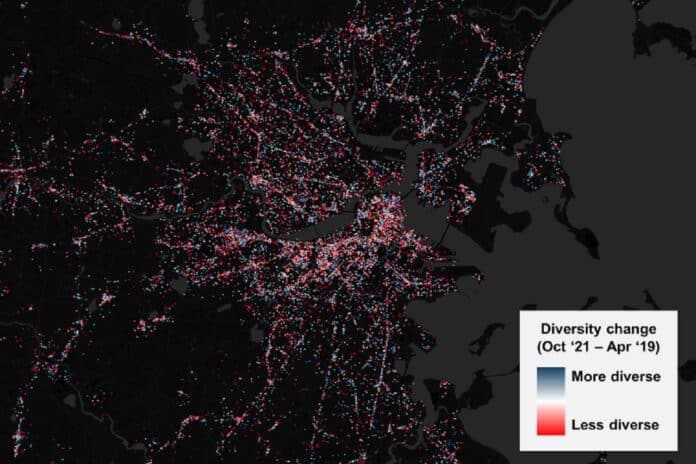A new MIT-led study has found that the Covid-19 pandemic has decreased urban residents’ interactions with people from different income brackets. The study examined the movement of people in four U.S. cities and found a 15 to 30 percent decrease in the number of visits to socioeconomically different areas. This has resulted in a reduction in opportunities for people to interact with others from varied social and economic spheres, which has continued even after mobility patterns recovered.
The Covid-19 pandemic has significantly affected the quantity and quality of physical encounters in cities, which are crucial for economic growth and resilience to shocks. Studies have used large-scale mobility data to measure the diversity of encounters in cities and have found that the pandemic has substantially decreased the income diversity of urban encounters, persisting even after the recovery of mobility metrics.
Changes in behavioral patterns, such as a lower willingness to explore new places and changes in visitation preferences, have contributed to this decrease in diversity. These findings suggest the need for urban policies to recover the diversity of urban encounters as we move beyond the pandemic.
Esteban Moro, a research scientist at MIT’s Sociotechnical Systems Research Center (SSRC) and another of the paper’s co-authors, said, “We see that changes like working from home, less exploration, more online shopping, all these behaviors add up, Working from home is amazing and shopping online is great, but we are not seeing each other at the rates we were before.”
The paper titled “Behavioral Changes during the COVID-19 pandemic decreased the income diversity of urban encounters” was published in Nature Communications. The co-authors include Yabe, Bulle Bueno, Dong, Pentland, and Moro.
Researchers analyzed anonymized cellphone data from 1 million users in four U.S. cities. They found that urban movement patterns have become more restricted post-pandemic, with a decline in exploring new areas. The study found that visits to leisure venues, transport sites, and coffee shops declined, while visits to grocery stores remained constant.
The researchers noted that decreased exploration could have long-term societal effects, weakening civic ties and valuable political connections. However, the researchers also suggest that policies can be implemented to bring people back to more diverse areas.
Researchers collected anonymized cellphone data from 1 million users in four U.S. cities over three years starting in 2019. They recorded visits to 433,000 specific “point of interest” locations, categorized the socioeconomic status of people into four income quartiles, and analyzed instances of visits to different income quartiles.
The study evaluated changes in urban mobility patterns during the COVID-19 pandemic and compared data from 2019 and early 2020 with data from late 2021, when urban mobility started to recover. The impact of public health policies on urban movement was also evaluated.
During the COVID-19 pandemic, urban mobility patterns changed significantly, with people exploring less and visiting fewer diverse places. The study used anonymized cellphone data from 1 million users in four U.S. cities to study changes in urban mobility patterns during the pandemic. The amount of urban movement overall was returning to pre-pandemic levels by late 2021. However, the scope of places residents were visiting had become more restricted.
Visits to more diverse places, such as museums and coffee shops, decreased significantly, while visits to grocery stores remained relatively constant. These changes in urban movement can have long-term societal effects, including reducing the diversity of social connections and weakening civic ties and valuable political connections.
The study concluded that the COVID-19 pandemic significantly changed urban mobility patterns, with people visiting fewer diverse places and exploring less.
While the overall urban movement was returning to pre-pandemic levels by late 2021, the scope of places residents were visiting had become more restricted.
This decrease in income diversity of urban encounters can have long-term societal effects, including weakening civic ties, social connections, and valuable political connections.
Journal Reference:
- Yabe, T., Bueno, B. G., Dong, X, etal. Behavioral changes during the COVID-19 pandemic decreased the income diversity of urban encounters. Nature Communications. DOI: 10.1038/s41467-023-37913-y
